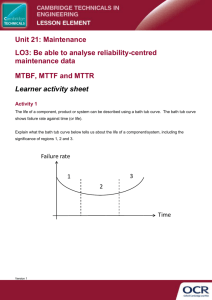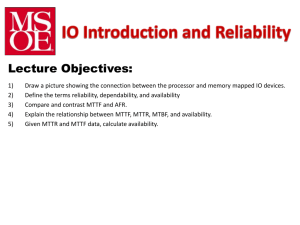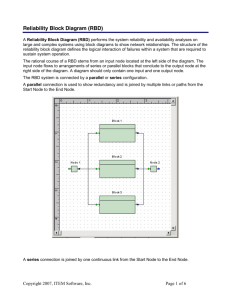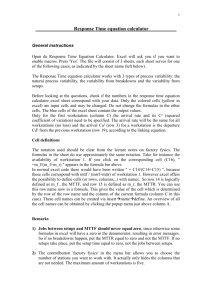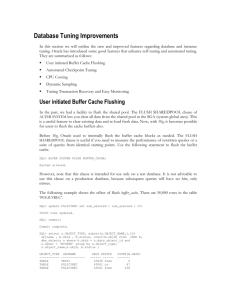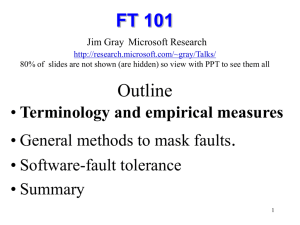MTTR “>>” MTTF
advertisement
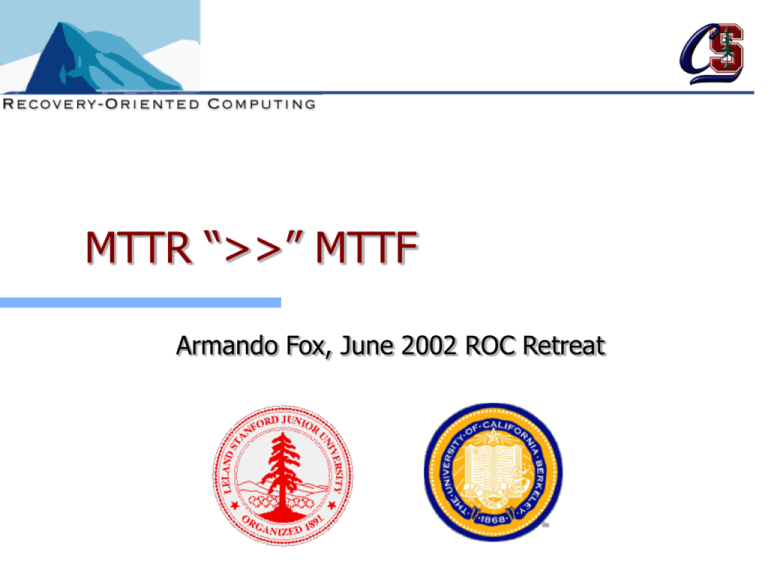
MTTR “>>” MTTF Armando Fox, June 2002 ROC Retreat Low MTTR Beats High MTTF Previous ROC gospel: A = MTTF / (MTTF+MTTR) 10x decrease MTTR just as good as 10x increase MTTF New ROC gospel?: 10x decrease MTTR better than 10x increase MTTF In fact, decreasing MTTR may even beat a proportionally larger increase in MTTF (ie less improvement in A) © 2002 Armando Fox Why Focus on MTTR? 1. Today’s MTTF’s cannot be directly verified by most customers. MTTR’s can, thus MTTR claims are verifiable. 2. “For better or worse, benchmarks shape a field” For end-user-interactive services, lowering MTTR directly improves user experience of a specific outage, and directly reduces impact to operator ($$ and customer loyalty). Increasing MTTF does neither, as long as MTTF is greater than the length of one user session. © 2002 Armando Fox MTTF Can’t Be Directly Verified Today’s availabilities for data-center-based Internet sites: between 0.99 and 0.999 [Gray and others, 2001] Recall A is defined as MTTF/(MTTF+MTTR) A=0.99 to 0.999 implies MTTF is 100x to 1000x MTTR Hardware: Today’s disk MTTF’s >100 years, but MTTR’s for complex software ~ hours or tens of hours Software: ~30-year MTTF, based on latent software bugs [Gray, HDCC01] Result: verifying MTTF requires observing many systemyears of operation; beyond the reach of most customers © 2002 Armando Fox MTTF Can’t Be Directly Verified (cont.) Vendor MTTF’s don’t capture environmental/operator errors MS’s 2001 Web properties outage was due to operator error “Five nines” as advertised implies sites will be up for next 250yrs Result: high MTTF can’t guarantee a failure-free interval - only tells you the chance something will happen (under best circumstances) But downtime cost is incurred by impact of specific outages - not by the likelihood of outages So what are the costs of outages? (Direct) dollar cost in lost revenue during downtime? (Indirect) temporary/permanent loss of customers? (Indirect?) effect on company’s credibility -> investor confidence © 2002 Armando Fox A Motivational Anecdote about Ebay Recent software-related outages: 4.5 hours in Apr02, 22 hours in Jun99, 7 hours in May99, 9 hours in Dec98 Assume two 4-hour (“newsworthy”) outages/year A=(182*24 hours)/(182*24 + 4 hours) = 99.9% Dollar cost: Ebay policy for >2 hour outage, fees credited to all affected users (US$3-5M for Jun99) Customer loyalty: after Jun99 outage, Yahoo Auctions reported statistically significant increase in users Stock: Ebay’s market cap dropped US$4B after Jun99 outage What about a 10-minute outage once per week? A=(7*24 hours)/(7*24 + 1/6 hours) = 99.9% - the same Can we quantify “savings” over the previous scenario? © 2002 Armando Fox End-user Impact of MTTR Thresholds from HCI on user impatience (Miller, 1968) Miller, 1968: >1sec “sluggish”, >10sec “distracted” (user moves on to another task) 2001 Web user study: Tok~5 sec “acceptable”, Tstop ~10 sec “excessively slow” much more forgiving on both if incremental page views used Note, the above thresholds appear to be technology-independent If S is steady-state latency of site response, then: MTTR ≤ Tok– S: failure effectively masked (weak motivation to reduce MTTR further) Tok – S ≤ MTTR ≤ Tstop– S: user annoyed but unlikely to give up (individual judgment of users will prevail) MTTR ≥ Tstop – S: most users will likely give up, maybe click over to competitor © 2002 Armando Fox Outages: how long is too long? Ebay user tasks = auction browsing and bidding Number of auctions affected is proportional to duration of outage Assuming auction end-times are approx. uniformly distributed Assuming # of active auctions is correlated with # of active users, duration of a single outage is proportional to # affected users another (fictitious) example: failure of dynamic content generation for a news site. What is critical outage duration? Fallback = serve cached (stale) content Theadline: how quickly updates to “headline” news must be visible Tother: same, for “second claass” news Suggests different MTTR requirements for front-ends (Tstop), small content-gen for headline news (Theadline), larger content-gen for “old” news (Tother) © 2002 Armando Fox MTTR as a utility function When an outage occurs during normal operation, what is “usefulness” to each affected end-user of application as a function of MTTR? We can consider 2 things: Length of recovery time Level of service available during recovery A generic utility curve for recovery time Threshold points and shape of curved part may differ widely for different apps Interactive vs. noninteractive may be a key distinction Tok-S Tstop-S © 2002 Armando Fox Level of service during recovery Many “server farm” systems allow a subset of nodes to fail and redistribute work among remaining good nodes Option 1 - k/N spare capacity on each node, or k standbys Assume N nodes, k simultaneous failures, similar offered load no perceptible performance degradation, but cost of idle resources Option 2 - turn away k/N work using admission control Will those users come back? What’s their “utility threshold” for suffering inconvenience? (eg Ebay example) If cost of admission control is reflected in latency of requests that are served, must ensure S+f(k/N) < Tstop (or admission control is for naught) © 2002 Armando Fox Level of service during recovery, cont. Option 3 - keep latency and throughput, degrade quality of service E.g. harvest/yield - can trade data per query vs. number of queries E.g. CNN.com front page - can adopt “above-the-fold” format to reduce amount of work per user (also “minimal” format) E.g. dynamic content service - use caching and regenerate less content (more staleness) In all cases, can use technology-independent thresholds for length of the degraded service © 2002 Armando Fox Some questions that arise If users are accustomed to some steady-state latency… for how long will they tolerate temporary degradation? how much degradation? Do they show a preference for increased latency vs. worse QOS vs. being turned away and incentivized to return? For a given app, which tradeoffs are proportionally better than others? Ebay: can’t afford to show “stale” auction prices vs CNN: “above-the-fold” lead story may be better than all stories slowly © 2002 Armando Fox Motivation to focus on reducing MTTR Stateful components often have long recovery times Database: minutes to hours Oracle “fast recovery” trades frequency of checkpointing (hence steady-state throughput) for fast recovery What about building state from multiple redundant copies of stateless components? Can we reduce recovery time by settling for probabilistic (boundedlifetime) durability and probabilistic consistency (with detectable inconsistency)? (RAINS) For what limited-lifetime state is this a good idea? “Shopping cart”? Session? User profile? © 2002 Armando Fox Summary MTTR can be directly measured, verified Costs of downtime often arise not from too low Availability (whatever that is…) but too high MTTR Technology-independent thresholds for user satisfaction can be used as a guideline for system response time and target for MTTR © 2002 Armando Fox
